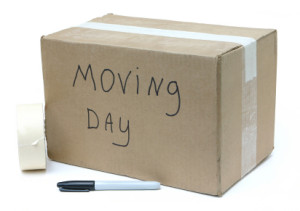Archive for the 'family moving' Category
By Relocation.com
When you sign a lease agreement, most likely you’ll be signing on for a set period of time, such as six months or one year. That means you’ll have to stay on for this amount of time or risk breaking your lease.
While many people do intend to stay long-term in their apartments or homes (after all, moving all the time can be costly) there are some unforeseen circumstances where you might be forced to break your lease before it us up, such as illness, job loss or other emergencies. If you absolutely have to break your lease agreement, here are some of the things you should consider.
Alternatives:
Before you try breaking your lease, there may be other things you can do first. You can ask your landlord if you can transfer the lease to someone you know (and have them move in and pay off the remaining rent for the lease term) or find a sub letter, who will be your responsibility for the time of the lease. In many cases, landlords hate breaking lease agreements because they don’t want to lose the income from the rent and/or don’t want to be bothered with having to look for tenants. If you make it as easy as possible for them, you may be able to get out of your lease unscathed.
Circumstances When You Can Legally Break Your Lease
There are three main circumstance wherein you can break your lease without penalty:
1) If the apartment or whom suffers serious damage through natural disasters, crime or other instances through no fault of your own.
2) If you suffer serious health issues which require you to live in an assisted living facility.
3) If you are called into active military duty after you’ve signed your lease
In these three cases, you can legally break the lease and your landlord cannot go after you for penalties.
Landlord Deficiencies:
If your landlord has been deficient in his or her duties, then you can also break your lease since he or she is not keeping up their end of the bargain. For example, if you’ve repeatedly sent requests for repairs and they ignore you, or if they’re supposed to pay for the utilities but haven’t (or have been keeping the payment for themselves if you give it to them) then you have just cause to break your lease. Make sure you keep good records (like written or e-mailed requests for repairs, etc.) so you can make your case, in the event that you have to go to small claims court or have been served with other legal documents and actions.
If you just want to break your lease because you want to move somewhere else, because you can’t pay or perhaps going through a divorce or separation, you may find it harder to break your lease. However, first talk to your landlord and offer the aforementioned alternatives, that way you can have a peace of mind when you coordinate other aspects of your move like locating moving companies.
By Relocation.com
For seniors and elderly people, moving can be a difficult time. There are many reasons why they need to move – illness, downsizing, or perhaps just moving in with another relative. If you’re helping an elderly friend, relative or parents move, then you have to be sensitive to their situation. Aside from that, moving can be stressful, and someone older may not be able to deal with the physical and mental stress, so try to help as much as they can. So, try to keep these tips in mind when helping the elderly move.
Start As Soon As Possible:
Starting as soon as you can will ensure you’re not rushing and that you won’t forget things. You can start by planning things out. Work out the important details first – the where, when and how before you even being to pack up moving boxes. Try to get some help or get a moving company to help you if the work really is too much. This will save you time in the long run and you’ll have more time to devote to your elderly person’s emotional and physical needs, rather than running around trying to move everything yourself.
Don’t Forget the Non-Material Things:
There are some essentials you can’t pack up in a box, so don’t forget to arrange for them. Medical and dental records are probably the most important, but also remember prescriptions and bank accounts, some of which can only be done by the person. You may have to take time to drive them around and get these switched to the new address.
Help Them Downsize:
Over the years, he or she may have acquired a lot of things. Chances are, not all of them are important, and some may have to be sold or thrown away. Help them sort things out. You can have a pile for throwing away, giving away, keeping and selling at a yard sale. This will also ensure that they can save some money on the move.
Take Care of Keepsakes:
Of course, there will also be some things that he or she may want to keep, such as photos, jewelry and other keepsakes. Take extra care of these as these may or may not have monetary value, but they certainly have sentimental value. Don’t pack them with the movers and keep them with you at all times.
Keep Them in the Loop:
Your elderly friend, relative or parent move, don’t keep them in the dark. You may think you’re that you’re protecting them or you think it’s not important, but they may feel confused or resentful if you keep things from them. Tell them all the details, like how you’re going to move, which moving company you’re using, and also take them through the details of moving day so they know what to expect.
Keep Essentials With You:
Don’t pack everything away – there may be some things they’ll need on the day of the move. Medications, sweaters, blankets – these may be some items that they need and will keep them comfortable during the move.
By Relocation.com
For many people, the prospect of moving to a city or town they’ve never been to may seem exciting and scary at the same time, and perhaps even terrifying if you’re moving somewhere without a job offer of some kind. However, many people today have no choice, especially if their specialties or interests are not in demands where they work or if the jobs are simply drying up in their area. Should you move somewhere without a job? People move all the time, and often without jobs. If you do decide to do this, make sure you make the necessary preparations before you start packing your bags.
Research the Market:
Make sure you do your due diligence before you even consider moving. Research the job market in the area you want to move to. Are your skills and experiences in demand in an area, or are jobs in your field plentiful? Another consideration is the types of jobs you’d be willing to take and of course, what is the minimum salary you need to be able to live in the area. You can find out the answer to these questions by browsing the local employment ads, calling up employment agencies or doing your own research as to the statistics in the local economy. Also, you may want to give your resume test. Send out your resume to local employers and see how they respond. Don’t forget to let them know when you’re moving into town or if you are available to travel to their city for an interview.
Compute Total Costs:
You’ll also have to figure out how much the long distance moving companies are going to cost you, as well as how much you need to live on while you’re looking for a job. A good rule of thumb is to budget around six months of living expenses (rent, food, utilities etc.), but this really depends on your background and what job or jobs you’d be willing to do. If you background is too specific, you may find a harder time finding a job, but if your skills are highly in demand or you’re willing to do different types of jobs, you might find a job within weeks. Either way, it’s better to be over prepared.
Finding an Apartment:
Most landlords will require potential tenants to provide employment information before letting you move in, which may be difficult if you don’t have a job yet. Try to explain the situation to your landlord and offer up the necessary paperwork for an apartment, like references or bank statements; you can even offer to pay a few months rent in advanced so they know you are serious about looking for a job.
Networking:
You’ve heard the saying that sometimes the best jobs are never advertised – this is almost always true in many cases (or they will be advertised, but they will eventually pick someone within the company.) So, use networking to your advantage. Call up people you know or friends of friends (or even friends of friends of friends) and ask them if they know any company who is hiring people in your field. Also, use the Internet. LinkedIn, for example, is a great professional networking site and is rich in information and networking opportunities like joining groups or attending web events and seminars. Use the power of your connections or don’t be afraid to make connections yourself so you can land that dream job interview in your new city.
By Relocation.com
If moving is hard for adults, it can even be harder for children. If you’re moving with your family, it is important that you make your children understand why you have to move and why they shouldn’t feel bad about it. The most common worries of children whether moving just across the town or moving to a ‘never-heard’ place are not being able to find new friends, getting bullied or set aside in their new school, not seeing their peers and not being comfortable with the entire place, new faces and all.
Books about Moving for Children
It is always best to inform your kids about the upcoming move as soon as possible. You need to give them time to think and allow themselves to accept it. One way to do this is to give them books about moving. There are books about moving for children that are written creatively. For sure, they would appreciate it. Other than having something to do while waiting for the moving day, they will also get the chance to understand the reason why you all have to move. Furthermore, you might not have all the time to oversee your kids during the day of move as you will be very busy looking after your belongings and making sure everything is ready. Giving them something to read can help ease their boredom and at the same time, can help them stay put.
Some Great Books about Moving for Kids:
I’m Not Moving, Mama
This is a story about a little mouse who refuses to leave his room on the very day of moving. You never can tell whether your kids are hundred percent ready to move even if you have told them about it weeks or months ahead. When the moving day comes, everything can get overwhelming for children that they end up doing tantrums, begging the entire family to just stay. This book can help your child cope with the anxiety that moving might bring.
Who Will Be My Friends?
As mentioned, one of the fears of children when confronted with the thought of moving is not being able to make new friends. This book is a story of a boy named Freddy and his journey to find new friends in the new neighborhood. It was hard in the end but eventually, Freddy was able to meet new friends and he was very happy.
We’re moving!
This story is about a little girl named Amy who has moved with her family. This book explains to children that getting comfortable in a new place takes time and effort but as days went by and new adventures come, everything will become normal as usual.
A Tiger Called Thomas
During the first days and nights in your new home, things can get very difficult for your child. The absence of friends and playmates can really make them feel alone and lonesome. Just like what Thomas felt on his moving story. But after a night of trick-or-treat, Thomas realized it’s not really that lonely being a new kid on the block.
There are more books about moving out there that your children will love. Encouraging them to read such kind of books will take away the negative feelings they have towards moving.

By Relocation.com
Congratulations on your exciting moving experience. Having a roommate in an apartment can be a tough experience. Even before you figure out your situation with your movers, you need to establish some necessary rules directly. You also have to learn how to confront problems in a nice manner so that your household will be peaceful. It is better to live with someone peacefully. You have to make some effort to establish a good roommate relationship, especially if you live in a dorm. It will help you enhance your college life experience. These are some suggestions on how to get along with your roommate. You need to know you roommate. Do not create unjust judgments, but find time to essentially talk and mingle with your roommate so that you can know her or him better.
Start a conversation. You can express your own habits and preferences. It is also important to know your roommate’s preferences. If in case, you are used of staying up late and you usually get up in the morning late, and he sleeps at 9 p.m., you have to make sure that you both know this and you can find a compromise. You need to cooperate with your roommate. If he usually sleeps early and you usually sleep late, make a system that can allow each of you to feel as if your needs is the same. You need to respect the opinions of your roommate, including his needs and wants. If he has an important exam or event the other day, do not insist on staying up late at night with the radio blasting and the lights on.
Set up a schedule. In order for the two of you to establish things easier without hurting one another, you should set up the rules and a schedule for chore delegations and study hours. Sticking to and planning your schedule can avoid misunderstandings and conflicts along the way. It can ensure that chores and study needs are compatible. If there are conflicts, you have to resolve them quickly. Do not let any problem fester. It will just lead both of you to further problems or complications and eventually hurt feelings that can possibly be the reason for either of you to move out. You have to remember that you are each a separate individual, both of you have distinct living styles and tastes and you cannot expect that your roommate will automatically get use to the way and manner you desire to live. You have to be open minded and flexible. Being overly inflexible about bedtime, cleaning or noise issues will bring no good. It will just create a gap between the two of you.
Make an effort to create friendship. You can do things together. It does not mean you have to share bathroom at the same time. It means you have to interact with your roommate. Do something enjoyable together and try to know her or him well. By watching a movie together, you can learn more about your roommate. Your relationship with a person or with your roommate will depend on the effort you put in to share interests with her or him.
At the start having a roommate is really tough but if are able to establish a good relationship with him, it is fun. You have to go along with the situation, create a positive energy between both of you. It can be an opportunity for yourself to learn and possibly, to create long lasting friendship.
By Relocation.com
After moving, you will have to think about how you will decorate your home. This starts by choosing proper lighting conditions for your home. Choosing lighting for your living room isn’t as easy as installing a single light bulb in the middle of the room, but neither is should it be a complicated task. The living room is your home’s most visible and public area and decorating it completely also means taking lighting design into consideration.
Lighting design considers the uses of the room and how lights may be placed to get an effect that is both functional and decorative.
When illuminating the living room, the key thing to remember is the living room is an area with so many uses, and its design and lighting must fit each of its different functions. The living room is primarily for entertaining, but people also go there to sit and relax, read, or maybe watch a movie or listen to music.
Main Lights:
The focal point in lighting this room is the main lights. These are usually found in the center of the room. They are decorative and dramatic, adding flourish to what would otherwise be a bare ceiling. If your ceiling is high enough, consider getting a chandelier, whether modern or traditional in design this type of lighting adds more than a dash of elegance to your room. You can also opt for simpler main lights but remember that eye-catching main lights really do make a difference to the finished look of the room. Main lights are good to turn on during parties and other festive occasions.
Dimmed lights/mood lighting
Watching a movie in the living room calls for dimmed lighting. This can be the recessed bulbs in the corners of the room, operated with a dimmer to keep glare out of the TV screen.
Lamps:
On the other hand, reading a book requires additional light and this is where lamps, and reading lamps, come in.
Lamps can be placed in corner tables, or right beside the reading couch, and provide focus spot lighting. Alternatively, stand lighting, similar to floor lamps but with bulbs facing upwards. Lamps can also provide area lighting around the living room. You can create a softly dramatic look in your living room by turning off all the ceiling lights, including main lights, and keeping the lamps on.
Spot Lights:
If your living room has paintings or shelves, etc, consider small spotlights that draw attention towards these. These lighting fixtures add accent to the room’s special highlights. You can also use spotlights, properly dimmed also as mood lighting.
Area Lamps:
You would also need area lamps to light up particular sections of the room. This is both energy saving and practical. Mood lighting is dim and soft, and if done right, transforms your living room into a cozy cocoon.
Coming up with the perfect lighting system for your living room means creating a combination of any one of the above. But first you have to consider what uses your living room is more frequented for and decide from there. Of course having all these elements together is ideal and creates the most dramatic lighting effect.

By Relocation.com
When moving to a new house, packing electronics require more attention compared to, say, your furniture. Electronic appliances need careful packing as they are fragile. They are also sensitive to dust, moisture, magnetic fields, pressure and vibrations. Pack them well to ensure you still get to use them (and they remain in tiptop condition) in your new home. Here are some of our tips:
Pack sets together. Some electronic equipment, for example stereo components and movie theater systems, come in sets. Make sure that you pack the sets together. If you accidentally misplace a part, you might be left with a hi-fi system that’s missing one speaker. You should also pack all the corresponding wires and peripherals together with the main system to save yourself the trouble of sorting them out again later.
Use moving boxes for storage. If you haven’t disposed of them yet, use the original moving boxes and paddings, otherwise sturdy corrugated carton boxes bought from the store or provided by the mover will serve the purpose.
Draw a diagram of the wiring. For reference in re-connecting wires and cables between components, draw a diagram of how the wires are hooked up to their corresponding terminals on the device. Note down the color coding scheme or attach matching tags to each wire-terminal pair. Bundle wires and cables securely and label them but do not bind or roll them too tightly to avoid internal damage. Optical fiber cables can easily break.
Secure loose/moving parts with masking tape. If you have a vinyl record player, disconnect the stylus assembly from the tone arm, put it in a small box and tape the box under the tone arm. Fix the turntable to the base with tape to prevent its movement and tape the tone arm to its rest. Lastly close the turntable cover and tape it to the base. Put small hardware items such as screws, nuts and bolts inside a plastic bag and tape the bag to the component where they came from.
Always label “FRAGILE, ELECTRONICS” on the sides and top of each box. When necessary put a “THIS SIDE UP” label on the sides of the box. It goes without saying that cargo items should be tagged with the name and address of the owner.
Before and during the move, keep components away from sources of liquids, wet surfaces, and strong magnetic fields. Provide water-damage protection by placing components inside plastic bags before packing them in boxes.
Pack to protect fragile parts. For components subject to risk of breakage or scratches like TV screens or computer monitors, pack them in such a way as to minimize stress or pressure to the delicate parts. Provide appropriate padding or spacers such as thick cardboard or styrofoam boards or pellets.
Cover speakers. Speaker units also need to be protected from possible dents to the cabinet and the acoustic cones. Cover the front of the cabinet with cardboard and wrap it over and around the edges. For heavy units, it’s a good idea to bind the box with packing tape to prevent bursting and tie it with heavy cord to provide handles for lifting.
Make sure the moving service company drives with care! Check whether the moving company has insurance coverage against loss or damage to cargo.

By Relocation.com
After you settled in from your moving experience, it’s time to think about the look of your home. If your current home décor looks old, tired and outdated, then now is the time to bring in a fresher look. There are lots of upcoming trends in 2012 you should check out, to help you find ideas for your next home improvement decorating projects.
Green is Always In:
These days, everyone is getting on the environmental bandwagon, so don’t get left behind! Going green not only helps the environment, but in many cases helps your wallet too, such as switching to eco-friendly light bulbs. You can redecorate your home to reflect an environmentally-conscious personality by using materials that are eco-friendly. For flooring, for example, you can use cork, instead of pricey hardwoods. If you want the look of marble, but don’t want the expense of the larger carbon footprint associated with having it shipped from abroad, a material called paperstone is perfect for countertops. It is durable and made from 100% post-consumer recycled paper. Using unbleached linens can lessen your impact on the environments, and even the simplest linen can make any room look good.
Good as Gold:
Long thought to be gaudy and a feature only used by “nouveaux riche,” gold is making a big splash in 2012. While silver metals have always been associated with class, a few touches of gold can make any room look elegant (just don’t overdo it.) Use it sparingly and only for accents, like gold throw pillow, gold tassels on your curtains or gold picture frames. Mix it up with some rich colors like purple to make it really pop. Brushed brass is also a good alternative, if you don’t like the too-polished look of gold.
Neon is Back:
Neon shades are making a big comeback, and it’s not just in fashion! Neon colors can really brighten up the room, the key is to not overdo it and stick to one color. These bright shades look best against neutral tones like gray or white, but try mixing it with softer shades. You might be surprised how neon green works with soft shades of blue.
Mix-and-Match:
Decorating has its rules, and many designers want to make sure that they keep pieces together according to style. However, this is the year to break the rules, and you’ll find styles and centuries mixing together. For example, an elegant art nouveau chair can look good in a minimalist apartment, provided it be the focal point. Don’t go crazy by mixing too many styles, and make sure the room still looks beautiful.
Men’s Motifs:
It seemed for a long time that decorating was purely a woman’s job and so many designs and prints are geared towards the ladies – just check any sample book or decorating magazine and you’ll see the prevalence of florals and paisleys, silks and satins. However, prints that have been traditionally “male” like pin stripes and houndstooth, as well as fabrics like wool and tweed are moving from the boardroom to the bedroom.
So, now that you know what to look forward to in 2012, start planning your next project today!

Pass the time when moving in a car with some of these creative activities
By Richard Farrell
Special to Relocation.com
Moving across the country in car is one way to save money. However, when you add kids into that mix you have to consider that they may get bored – especially when you will be driving for hours on end. Check out some of our creative solutions to make it easier to get to your new home when driving.
Planning the Trip:
- Once you have chosen your route, it is time to calculate how long you are going to be a passenger or driver in the car. Allow for unforeseen delays such as traffic backlogs and diversions along the way. Once you know your likely journey time you can plan around it better.
- Pack a cooler of healthy snacks and lunch options for your initial ride. Once you get on the road, plan to use drive-through food outlets along the way as this will save a lot of time. Keep a couple of trash bags handy for any garbage.
- Wear sensible clothing and shoes for the journey. Choose comfortable shoes and clothing that are easy to slip off so that you can relax and let your feet breathe. Long trips will likely result in posture issues and your feet will soon remind you of the fact that you are not comfortable. Shoelaces are not practical in these circumstances.
- Should you be sharing the driving, do make sure you stop in a safe place and take time out to walk about and do some breathing exercises before you take the wheel. Include some stretching exercises too..
- Consuming of alcoholic beverages immediately before or while traveling makes for another definite “no.” Apart from affecting your reaction time it is breaking the law and your journey to your new destination will be remembered for all the wrong reasons!
7 Fun Tips to Pass Time in a Car:
- Bring CD’s. Sort through your CD collection and pick out some favorites and maybe a couple that you have not played for some time.
- Radio. Satellite radio played through your car sound system is of excellent quality and clarity. Tune in to your favorite stations before you set off.
- Books and Magazines. Kids love books and magazines. Make sure you have plenty for the journey.
- Music DVD’s. You may be lucky enough to have a sophisticated in-car system. If not, then there are plenty of good quality portable players for you to enjoy the latest movie offerings as well.
- Take Naps. Short napping is good, but sleeping the entire journey may be considered antisocial, and besides you will be missing the passing scenery and could arrive feeling less than your best.
- Food. Choose snack food that does not make a big mess. Dry snacks such as chips and peanuts or glazed dry fruit are great for the car. Avoid too much intake of food and drink or you will be stopping at every restroom along the way.
- Rotate Drivers Regularly. This is very important for long journeys. If you are the only driver you will need to consider breaking your journey with an overnight stop. In any event, do stop every 90 minutes but make sure you pull over in a safe place.



Image Credit: Active Rain
By Relocation.com
There are several things to think about when changing schools for the kids. Starting with the educational offerings and then questioning the safety, affordability, transportation options and location. If you’re moving somewhere far (or at least far enough to change school districts), here are some issues you may think about when choosing a new school for your kids.
1. Security – Choose a school with great security features for the kids. Find out what they do to keep your kids safe from harm, and if there have been any other issues in the past.
2. Level of education – Schools always differ in levels of education. Although it may not be prominent, if you do a closer look at their alumni and their teachers to help you assess it.
3. Activities – Kids will mostly likely learn from activities faster than they do in classrooms. This has been scientifically proven. When they participate in events, they learn at higher rates. Activities also help develop confidence and will give boost to your child’s potential. Find a school with a good mix of activities – sports, arts, social clubs – so that they’ll have a wide range to choose from.
4. Transport and distance from home – Know that your kids may get stressed from long trips. Try to have a good proximity from your kid’s school. Kids often have the urge to stay close to home as much as possible, especially for toddlers.
5. Resources – if you are going to transfer your kid to another school, be sure to get him a new school with better resources. Better libraries, good classrooms, wider spaces – these matter to kids who are growing up and learning.
6. Cost – Finding a school that gives the best education that fits your budget may be challenge, but with research you’ll be able to do this. You can also find alternatives, like charter schools, or you can help your kids by augmenting their education with after-school programs or private tutors.
Changing schools for kids can be scary. Always try to consider their preference and try to put yourself in their position. When a kid changes schools most of the time he has to deal with the adversities of finding new friends and getting to know the place. This is what the kids are always thinking about, and perhaps not so much their education. Here are more tips on how to understand your kids’ feelings and help them move on to their new surroundings.
1. Friends – This is your kids’ priority. Try to encourage them to find new friends and get them out there to open up conversations. If your child is shy from the start, try to help them out by approaching other parents and introduce your child.
2. Bullies – for the first months, please do try to check on your kids. Bullies often target new comers, but will always be afraid of parents and teachers. Try to maintain a good presence.
3. Teachers – get to know their teachers and ask for feedback. Your kid is new and ask for everything that you need to know about the school.
4. A good playground – This is always good for younger kids. This is the best place for your kid to socialize and find a new circle of friends for him or herself

Moving with a teenager doesn't have to be difficult. Check out our tips for making this move easy!
By Dermound Becker
Special to Relocation.com
The stresses, strains, upheavals and turmoil of moving are difficult enough, but when you add teenagers to the mix, chances are things will be even more complicated. Not only do teenagers have raging hormones and pendulum-like mood swings, they generally, do not react well to change. When a family moves, they will have to leave everything that is safe and comfortable including their school, sports and other extramural activities and, most importantly, their friends. This could be a recipe for catastrophe, if it is not handled with a delicate hand and a lot of understanding.
The most important step to inform your family that you will be relocating to another area early on. Sit down with them and explain the reason for the move – whether it is for financial reasons or a new job. The main thing is to be honest and direct with your teens. Many teenagers feel that they are already adults and therefore need to be consulted on such a momentous decision; others will suddenly feel that they are not yet adults at all and will feel very vulnerable to the consequences of the move.
Throughout the process of planning, organizing and packing, take the time to listen to what your teenager has to say. Having a sympathetic ear may just be the lever needed in order to get him or her to get involved with the move, start sorting their possessions and maybe even begin packing a few boxes of their own. You may be surprised to learn that your teenager may even relish the thought of a move, if perhaps his or her current peer group is a bit boring and they actually need a change.
If at all possible, try to plan your move at the end of the school year, or at least at the end of a semester, as this will be the least disruptive to your teenager and will have the least impact on their social life and their school work. If you have no choice as to when you have to move and it is very close to the end of your teenager’s school life, think about organismic for him or her to stay with relatives or friends until the completion of their studies.
Another aspect which is imperative when relocating a teenager is to ensure that he or she is not completely cut off from their friends. This means that they should be given one of the latest gadgets to allow him or her to e-mail, tweet, or send MSM messages to keep up with the latest news and to be able for them to report on their new lives. Organize a Skype connection with a camera so that they will be able to see their friends as well.
Finally, if you will be buying or renting a home in the new area, involve your teenager and listen to his or her opinions to make them feel that they are important members of the family and that their opinion is valued.

These tips will make your miliary move easier
By Dermound Becker
Special to Relocation.com
In general, families in the military move from one base to another – and even from country to country – about once every two years on average. Since moving is such a great upheaval it can be especially difficult for military families to cope and manage with the constant packing and unpacking.
As with all moves, basic organization and planning are the keys to a successful and less stressful relocation. Listed below are some tips for military families who have to move often.
The first step is to set up a meeting with the transportation office on the base where you are currently located. During this meeting you will be given certain forms which must be filled in, in order for those in charge of this office to process your details and ensure that you have all the information you may need to, for example, apply for a Dislocation Allowance (an allowance to help pay for all sorts of miscellaneous expenses); for a temporary housing allowance, or for any other of the numerous financial benefits which may be available to your family. You will also be given information on the two ways of making the move, because military families have two programs to choose from when it comes to moving from base to base. One is that the government will actually transport your household possessions for you. The other option is the DIY method. Should you choose to move your belongings yourself, you will be reimbursed about 95 percent of what it would have cost the government to use their moving services.
Along with the planning and organization, families should also downsize and get rid of absolutely everything they don’t need. With clothing, this means anything that you have not worn in the past year. Downsizing will ensure that you do not have to pack and then unpack (and find place for) items for which you no longer have any use. Donate these items to charity, ask friends or family if they would like to have them or, as a last resort, have a garage sale.
For safety and security reasons, keep all your personal important and legal documents with you – do not pack them into boxes for the moving company to take away for transportation.
Take photographs of any of your valuable items so if anything gets damaged or lost, you will have a record of such objects.
Finally, make a list of what you have packed into each and every box and, once they have been sealed, write on them in clear handwriting exactly which room in your new home the boxes need to be put in. This will help enormously when it comes to unpacking and organizing your new home.

Be sure to do your research before moving to a new neighborhood.
Moving is a big step in your life that you really want the location you choose to be the very best for you and your family. Here are some things to consider when you are searching for the right neighborhood.
Check on the schools. If you have children, you are going to want to closely check on the area schools. You can start by reading online what ratings schools receive as well as online forums my parents. If you can, visit the schools and spend some time with teachers and observe how the school appears. Do they have after school programs? Do they appear to have supplies? Talk, if you can, to some parents and get a good idea of how they feel about the school.
Visit the local parks. Again, if you have children, check out the local parks. Are they well kept? Are there any activities held there? Do they appear to be safe, both during the daytime and at night?
Observe the neighborhood. Is your neighborhood well lit at night? How safe does it appear to be? Is there a neighborhood watch program? How noisy is it at night? And how is the traffic in the area? Is there adequate parking?
Check out the hospitals in the area. Are they close? Are they well established? How long is the average emergency room wait? You can find out a lot about local medical care by checking online. You might want to also look at pharmacies in the area, and perhaps check out urgent cares as well.
What types of stores are in the neighborhood? Do they open early (if you are a morning person) and what time do they close at night (if you are a night owl)? How convenient is shopping going to be for you? Is there parking available?
Check out the public transportation. Is it convenient to your home or apartment? How expensive is it? How late/early does it run? If you needed to use it to get to work, are you sure that it will be running when you need it? How about if you want to go shopping using it, or go visit a relative? How clean is it and does it appear to be safe and well-maintained?
Research the crime rates. You can usually find this information out online as well. What are police response times? Are there any sex offenders living close by? Look online for forums or message boards about your neighborhood. Many times, residents will complain about problems in the area that you will certainly never hear from a realtor. You may be able to find out a lot about things like local ordinances, property taxes or other problems.
Moving to a new neighborhood is a huge change in your life. Make sure to do your research so that you know you know you made the right choose when deciding on a new location.

Chat with your friends before you move to ease any moving day tension.
By Dermound Becker
Special to Relocation.com
Moving to a new city can be both bitter and sweet. As excited you are about the new adventure in your life, you must also leave behind your loved ones. Telling friends and family that you have decided to move can be a traumatizing experience. Here are some tips to make your moving day easier.
Tell people sooner rather than later. If you put off telling your loved ones about your decision, you give them less time to get used to the idea. You limit the time that you can spend with them before the movers arrive. As much as you are dreading the idea, you really will be better off if you broach the subject early on. Even if they are upset, it will still give you time to explain the reasons for the move to them, answer any questions they may have, and just to enjoy the time you have together while you can.
Assure your friends and family that you will stay in touch. One big fear that comes up often when someone hears that a close friend is moving away is that this will be the end of the relationship. Make sure that these people close to you can, for instance, have a way to contact you. Luckily, these days it is even easier to stay in touch such as through blogs, email, Skype, or even writing a letter. Follow this up by contacting them as soon as you can after your move.
Decide who you want to tell. You need to decide exactly who you want to tell and just how you want to tell them. You could consider having a cook-out or picnic and inform everyone at the same time. Or you might want to have individuals over for coffee, or meet them for lunch, and tell them separately. However you decide to do it, expect tears and be prepared with tissues.
Be prepared for questions, and have answers. People who care about you want to know that you are making a good decision. Explain things carefully. If this is for a job, tell them all about what a great opportunity it is for you, for example.
Keep them informed. Let them know how things are progressing with the move. Give them your new address ahead of time. Assure them that you will call along the way, or when you have safely arrived. Any assurances you can give them will help soften the blow of losing you.
Everyone will react differently. Not everyone is going to be happy to hear your moving news. If you must, be firm with them about the fact that this is actually going to happen. You do not want to lose a close friend over this if you can help it, but then again, you have to think of yourself and your best interests first. Just give them time to come around.
As soon as you are settled in, send pictures and updates to your friends and family members. Let them see your new home, your neighborhood and where you work or go to school. Let them see how happy you are in your new area. Good friends and loving family will want you to be happy, after all.
April 4th, 2011 by
Admin
Categories:
Celebrity Real Estate,
condos,
family moving,
foreclosures,
homes for sale,
House Swap,
Moving,
Moving Day,
Moving Industry,
Real Estate,
Relocation,
rentals Comments:
No Comments » 
The Kentucky Versailles Castle - Listed for $30 million. (Image Credit: Kentucky.com)
This week we are loving the gorgeous pictures of the castle Kentucky that is currently on the market. Constructed by Rex and Caroline Martin after their trip to France the home was left unfinished after the couple divorced a few years later. Now listed for $30 million, the massive castle is currently run as an inn and bed-and-breakfast that is being looked at by several interested buyers. On the rest of the Beat we featured celebrity homes for sale in California. Molly Sims recently listed her Hollywood Hills home as did Meatloaf and Burt Reynolds. As we get into spring, we are excited to check out what new properties will be featured on the Beat. Until next time…

Shot of the Kentucky Versailles Castle - (Image Credit: Zillow.com)
• Kentucky’s Versailles Castle for Sale
After a trip to Versailles, France in 1968 Rex and Caroline Martin were inspired to create their own castle right in Kentucky. They later divorced in 1975 and the uncompleted castle was left unused until Rex’s death in 2003. According to Zillow.com, it was later sold for $1.8 to Thomas Post who rebuilt it as a bed-and-breakfast/inn that has since been open for rentals and special events like weddings and fundraisers. Located on Versailles Road between Lexington and Frankfort, the stunning 50-room castle is now on the market for $30 million, according to Kentucky.com. There are talks that at least two people from South America are interested in purchasing the castle and if they do they can look forward to a 50-acre estate with stone walls, gardens, fountains, a tennis court and a huge pool. The new buyer can also look forward to having a game room, a library, a dining room as well as opulent window and home furnishings.

Molly Sims' modern kitchen - Listed for $2.8 million. (Image Credit: Zillow.com)
• Molly Sims Listed Her Hollywood Hills Home for $2.8 Million
Model and actress Molly Sims recently placed her gorgeous Hollywood Hills home on the market for $2.8 million. The Spanish-style home, built in the 1930s, includes three bedrooms, 3.5 bathrooms, and a modern kitchen with Viking appliances. The immaculately-styled home was also featured in InStyle magazine.
![KourtKardashian_PICS[1]](http://blog.relocation.com/wp-content/uploads/2011/04/KourtKardashian_PICS1-210x300.jpg)
Pics of Kourtney Kardashian's new home - Purchased for $1.7 million. (Image Credit: The RealEstalker)
•
Kourtney Kardashian Buys a New Home
Kourtney Kardashian of “Keeping up with the Kardashian” fame recently purchased a new home for $1.7 million. Located in Calabasas, California, the four bedroom, 4.5 bathroom room also includes an office, library, guest room, fitness room and a media lounge. The 5,334-square-foot home also includes a wine cellar, a fireplace, a game room, and a modern kitchen with stainless steel appliances and a breakfast nook as well as gorgeous views of the hills.
![MeatLoaf_CAL[1]](http://blog.relocation.com/wp-content/uploads/2011/04/MeatLoaf_CAL1-111x300.jpg)
Pics of Meat Loaf's home - Listed for $3.2 million. (Image Credit: The Real Estalker)
•
Meat Loaf is Selling his California Estate
Singer and current participant of “The Celebrity Apprentice” is currently moving from his Calabasas, California estate. Listed for $3.2 million, the 7,142 square foot estate includes seven bedrooms and seven bathrooms that once featured in
Architectural Digest for its impressive décor. The new owner can also look forward to a three-car garage, a formal living room, a fireplace, a media room, and a custom-made kitchen.

Burt Reynolds home - Listed for sale at $10.9 million. (Image Credit: Zillow.com)
• Burt Reynolds’ Home for Sale at $10.9 Million
Burt Reynolds recently listed his Los Angeles home for sale for $10.9 million. His modern 20,580-square-foot glass home features stunning views of the city and the ocean. The home was recently designed by Steve Hermann who updated the home to feature numerous amenities such as a state-of-the-art kitchen and a large family room. The home also has four bedrooms and four bathrooms.
Don’t forget to like us on Facebook and follow us on Twitter!
• Follow us on Twitter @Relocation_News
• Become a fan of Relocation.com on Facebook
March 16th, 2011 by
Admin
Categories:
Celebrity Real Estate,
condos,
family moving,
foreclosures,
Home Improvement,
homes for sale,
House Swap,
International Moving,
Mortgages,
Moving,
Moving Day,
Moving Industry,
Plan Your Move,
Real Estate,
Relocation,
rentals Comments:
No Comments » By Serena Norr
This week ended up being an all-homes-for sale edition of the Beat, and boy, were there some interesting ones on the market. Starting in NYC, we featured the $90 million dollar estate that was once owned by the Woolworth family. The mansion, now owned by Lucille Roberts’ family, includes 10 bedrooms and 11.5 bathrooms. For a smaller amount (and not much), you can purchase Dennis Quaid’s home in the Pacific Palisades, Mary J. Blige’s home in New Jersey or Christine Aguilera’s home in Beverly Hills. Kelsey Grammer is also selling his Avon, Colorado home this week for $7.9 million. Still too rich for our blood, we’ll simply admire this luxurious real estate eye candy. Until next week…

View of the $90 million dollar Woolworth mansion. (Image Credit: Curbed NY)
• Woolworth Mansion for Sale at $90 Million
The former Gothic-style townhouse once owned by Frank Woolworth (of the nickel and dime store) has recently been place on the market for the staggering asking price of $90 million dollars! Located on East 80th Street in NYC, the 18,000-square-foot mansion, now owned by Lucille Roberts (the fitness mogul), includes lavish amenities such as three kitchens, 10 bedrooms, an elevator, a library and 11.5 bathrooms. The massive complex, designed by famed architect Charles Pierpont Henry Gilbert, also includes 14-foot ceilings, seven floors, eight fireplaces, a gym and a suite for staff members. Roberts purchased the home in 1995 for $6 million but passed away in 2003 – which is why her family is looking to sell the opulent mansion. For those that can’t fork over the $90 million dollars, the home is also available as a rental for $210,000/month.

Exterior Shot of Dennis Quaid's Home - Listed for Sale at $16.9 Million. (Image Credit: Zillow.com)
• Dennis Quaid Lists Pacific Palisades Home for $16.9 Million
Famed actor and musician Dennis Quaid is reportedly selling his Pacific Palisades home for $16.9 million in order to relocate to Texas. The French-style home, purchased in 1999, has been completely renovated by Quaid and includes a guest house, three bedrooms, three bathrooms and a huge barn for several horses. The two-acre home also includes 8,400-square-feet of living space, a modern kitchen, an office, a pool and a wine cellar that is situated amidst a backdrop of sprawling trees and luscious greenery. If sold at $16.9 million, the home would average a profit of about 823.5 percent, according to Zillow.com.

Pictures of Mary J. Blige's New Jersey Mansion - Listed for Sale at $13.9 Million. (Image Credit: Housing Watch)
• Mary J. Blige Lists New Jersey Mansion for $13.9 Million
Hip-hop mogul Mary J. Blige is reportedly looking to sell her New Jersey mansion for $13.9 million dollars. Located in Saddle River, New Jersey, the 25-room mansion features a gourmet kitchen, a movie theatre with 14 seats, a wine cellar, an indoor basketball court, a six-car garage and 18,250-square-feet of living space. The 4.2 acre house was originally listed at $17 million in 2008 and recently dropped to the current asking price.

Christina Aguilera's Beverly Hills Mansion - Listed for Sale at $13.5 Million. (Image Credit: The Real Estalker)
• Christina Aguilera Places Beverly Hills Home on the Market for $13.5 Million
Pop singing sensation Christina Aguilera recently listed her Beverly Hills estate for $13.5 million. The 10,000-square-f00t home (once owned by the Osborne’s) includes six bedrooms, nine bathrooms, a formal living room, a home theater, a library, a recording studio and an in-home hair salon. The home also includes a massive backyard equipped with a pool, lounge and built-in barbeque area.

Kelsey Grammer's Colorado Ski Home - Listed for Sale at $7.9 million. (Image Credit: The Real Estalker)
• Kelsey Grammer Lists Colorado Ski Home for $7.9 Million
Kelsey Grammer of the hit shows “Cheers” and “Fraiser” recently listed his Avon, Colorado ski estate for $7.9 million. The recently divorced and remarried TV star is looking to sell this 8,230-square-f00t home as part of his settlement with Camille Grammer (of “The Real Housewives” fame). The gorgeous three-story vacation home includes six bedrooms, 7.5 bathrooms, stone fireplaces, a gourmet kitchen and a wine tasting room that is situated on 1.67 acres.
Don’t forget to like us on Facebook and follow us on Twitter!
• Follow us on Twitter @Relocation_News
• Become a fan of Relocation.com on Facebook

Moving Announcement Cards by Tiny Prints. (Image Credit: Tiny Prints)
By Serena Norr
Congratulations on your exciting move. This will be a (very) busy time for you as you research and locate movers, pack, and of course, leave your old home. Another thing on your growing to-do list should include letting your friends and family know that you are moving by announcing your move and providing them with your new contact information (address, phone number, email address, etc). One way to do so is by sending out a moving announcement either as a postcard or through an e-card – here are some of our favorite options.
1. Tiny Prints. The adorable moving announcements by Tiny Prints feature a wide-range of styles and patterns from contemporary and modern to more traditional cards to announce your move. We love the Simply Understated: Basil Cards and the Beep Beep Bug: Agua Cards that allow you to add a picture. The price for these moving announcements is also right averaging around $1.00/per card.
2. Purple Trail. With everything involved with the moving process, ordering and sending out cards might not fit into everyone’s schedule. As a website, we love quick and simple and found that on PurpleTrail.com. This online invitation site (they also offer cards you can order and mail out), features over 50 moving announcements that you fill out in their browser. You can add a personal message, upload photos and add creative design elements from Purple Trail’s library. Even better? Purple Trail is a free service when you send 75 cards or less.
3. Make your Own. For those craft mavens out there, consider making your own moving cards. This definitely requires some planning (and time) but if you are able to manage both then making your own cards can be a fun way to announce your move as you add your own personal design and flare. This can also be a fun project for kids and a great way to keep them busy while you are dealing with the organizing of your move. In your own cards, be sure to include your forwarding address, new phone number and email address.
Don’t forget to like us on Facebook and follow us on Twitter!
• Follow us on Twitter @Relocation_News
• Become a fan of Relocation.com on Facebook
March 7th, 2011 by
Admin
Categories:
Celebrity Real Estate,
condos,
family moving,
foreclosures,
homes for sale,
House Swap,
International Moving,
Mortgages,
Moving,
Moving Day,
Moving Industry,
Moving with Kids,
Moving with Pets,
Packing,
Plan Your Move,
Plan Your Relocation,
Real Estate,
Relocation,
rentals Comments:
No Comments » The wacky and wild world of celebrity real estate did not disappoint this week. First, we have Charlie Sheen and his never-ending media circus has once again made the news – except this time it is within the real estate segment. He recently purchased a 9,020-square-foot mansion in Sherman Oaks, California that is reportedly for his ex-wife and their two children. On the rest of the Beat you will find homes listed on the market – ranging from Jennifer Aniston’s $42 million mansion to Julianne Moore’s $12.5 million dollar NYC townhouse. Those amounts are a bit out of our price range but we look forward to reporting on who the lucky buyers are. Stay tuned…

Charlie Sheen's New Mansion. (Image Credit: The Real Estalker)
• Charlie Sheen Buying a New Mansion
Much has been said about the drama involved around Charlie Sheen and his media circus and now he is making news within the real estate market with his recent purchase of a mansion in Sherman Oaks, California. Purchased for his ex-wife Denise Richards, the $7,495,000, 9,020-square-foot estate includes an elevator, six bedrooms, nine bathrooms, a library, a formal living room and a gourmet kitchen. The two-story gated home also includes a formal backyard with a swimming pool and spa.

Jennifer Aniston Lists Beverly Hills Home. (Image Credit: The Real Estalker)
• Jennifer Aniston Lists Beverly Hills Mansion for $42 Million
Jennifer Aniston has recently been featured on the Beat as she has been scouring NYC for a new condo. No word yet on whether a home has been picked but there is news this week that she placed her Beverly Hills estate on the market. Listed at a whopping $42 million, the 10,000-square-foot Asian and Balinese-inspired home includes five bedrooms, 7.5 bathrooms, two living rooms, a gourmet kitchen and a home gym. The home is also said to include state-of-the-art smart house technology, an extensive security system, tons of storage space, a three-car garage and an outdoor swimming pool. Originally purchased in 2006 for $13,500,000, we’ll be sure to let you know who buys this luxurious (and expensive) property.
• Julianne Moore’s West Village Home is on the Market
Actress and children’s book author Julianne Moore originally listed her five-floor West Village townhouse for $11.995 million in 2009 – unable to find a buyer the home has been re-listed for $12.5 million. Built in the 1800s, the six-bedroom, 3 bathroom home, includes a gorgeous 49-foot garden, eat-in kitchen, a high-tech security system, a home office, media room and a laundry room.

Tom Brady's floorplan. (Image Credit: Curbed NY)
• Tom Brady Selling Time Warner Center Condo
NFL star Tom Brady recently listed his three-bedroom condo for $14 million. Purchased in 2006, the condo, located in Time Warner Center, was then re-listed shortly after in 2007 where it has since been rented for $50,000/month. It has been reported by the Journal that the condo has a seller who is expected to enjoy a home with incredible light, oak flooring, a modern Chef’s kitchen with state-of-the art appliances, granite counter-tops and customized cabinetry.

Cher's former home. (Image Credit: The Real Deal)
• Cher’s Former Home Reduced to $10.2 Million
The Gorce Island mansion home formally owned by Cher in the 1990s has recently listed has recently been to $10.2 million. Located off of Miami Beach, the luxurious 11,460-square-foot mansion, owned by investor Armin Mattli, includes upgrades of about $1 million dollars, a 60-foot pool, and 158-feet or water front. The three-story home also has six bedrooms, seven bathrooms and a two-story hall embraced with double staircases. Originally listed for $16.9 million in 2008 and then for $11.5 in July – making this recent drop at least 40 percent below the market price.
Don’t forget to like us on Facebook and follow us on Twitter!
• Follow us on Twitter @Relocation_News
• Become a fan of Relocation.com on Facebook
March 3rd, 2011 by
Admin
Categories:
family moving,
Moving,
Moving Day,
Moving Industry,
Moving with Kids,
Moving with Pets,
Packing,
Plan Your Move,
Plan Your Relocation,
Real Estate,
Relocation,
Relocation Data Comments:
No Comments » 
Tips to Ease Moving Day Strain When Pregnant
By Serena Norr
Sometimes you have to move, regardless of whether you want to or not. One of those special situations occurs during pregnancy. With all of the ups and downs that occur during this time, adding moving to the mix can increase a mother-to-be’s level of stress and anxiety. No need to fret, Relocation.com is here to help you make this transition as smooth as possible; whether you are moving down the block or to another state or across the country.
1. Move in the Middle:
If you have any sort of flexibility, move during your second trimester. The nausea and tiredness from the first trimester will likely have passed, leaving you feeling energized and pretty good (in general). This will be beneficial when you move, especially since your day may involve long travels, organizing boxes and dealing with movers.
2. Prepare for the Move:
In general, a successful move is determined by how organized and prepared you are. This involves planning your move by locating movers (and picking individuals that you trust), as well as obtaining boxes, packing and locating a storage facility. When looking for moving companies, ask friends and family members for referrals. You can also locate reputable and local movers online through Relocation.com. When calling moving companies, never accept an offer over the phone and be sure to research and then invite at least two-three movers to your home for an in-house moving estimate. This is the best way for movers to actually see your belongings (thus determine the price) as well as a great opportunity to interview them and ask them specific questions pertaining to your needs.
Tip: Since you are with child, make sure that you pace yourself when completing these tasks. It is best to give yourself extra time to stay on top of everything that needs to be done (writing things down helps), which will also prevent you from getting too stressed out along the way.
3. Ask for Help:
You are going to need help with your move. Even if you have a small move, be sure to ask friends and family members for their assistance with anything from packing to calling movers to locating storage. If you can, assign your helpers specific tasks in order to stay organized – having efficient and step-by-step moving checklists are great for this. You can also have your moving company do all of the packing (for an additional fee).
4. Organize your Items:
Hopefully you have some very handy helpers to assist you with your packing, but if not you can stay organized by devising a packing systems for your belongings. Through this efficient plan, organize your items into three piles: pack, donate and toss. The items that don’t work or maybe have holes in them are likely items to toss. The donate pile may be items of clothing that you no longer like or those that don’t fit to be given to friends or charity; while the keep pile are items that will move with you to your new home and can be placed in boxes. This moving system is also a great way to start fresh and get rid of old junk before the new baby. Stay organized throughout the packing process by labeling all of your boxes based on what room the items will be placed. This is also a great way for the movers to know where your belongings should go.
5. Test your Home:
If you are moving into an older home be sure to have it tested for lead. Although you likely had a home inspection, make sure that this also included looking for metals, lead and asbestos. This problem is common in older homes and even in homes that have undergone renovations where walls were simply covered and not stripped of these hazardous materials.
6. Rest and Rest Some More:
It’s finally here; your moving day! This goes without saying but be sure that you get plenty of rest before your move. During the move, be sure to take breaks to rest and stretch, use the restroom, drink tons of fluids and don’t strain your body. This includes not getting stressed out when the inevitable problem happens on moving day. Also, be sure that you are comfortable by wearing comfy shoes and loose fitting clothing and don’t lift anything heavy. Luckily, you don’t have to prove you are supermom on moving day, especially since you are prepared, organized and have a few helping hands to assist you along the way.
Don’t forget to like us on Facebook and follow us on Twitter!
• Follow us on Twitter @Relocation_News
• Become a fan of Relocation.com on Facebook
February 22nd, 2011 by
Admin
Categories:
condos,
DIY Move,
family moving,
foreclosures,
homes for sale,
House Swap,
Moving,
Moving Day,
Plan Your Move,
Plan Your Relocation,
Real Estate,
Relocation,
rentals,
Travel Comments:
No Comments »
Looking to buy a home in Hawaii? Whether you’re relocating to the islands or thinking of buying an investment property, finding the right piece of Hawaii real estate requires time, effort, and yes, an island visit — or two! Though you can easily narrow down prospective island properties with a myriad of online tools, virtual house hunting can only take you so far. There’s no substitute for the real thing.
Visiting Hawaii isn’t exactly a hard sell, but if you’re new to the islands; it can still be daunting. Here are some quick tips to keep in mind before you book your trip.
1. You don’t have to splurge on a hotel.
There are two versions of Hawaii: the one you see as a tourist, and the one you see as a resident. Though there is a massive amount of resources and services available to tourists, things work very differently for locals. While you’ll probably have to stay in a hotel, keep it simple. Forget the ocean view or the upgrade to a suite, and don’t rule out discount chains. After all, the point of visiting Hawaii is to spend as little time as possible in your hotel room. And you don’t want to mistake tourist luxury for day-to-day reality. You might even want to consider a Hawaii vacation rental… though be careful: these are tightly regulated, and not all of them are legal operations.
2. Be flexible on transportation.
For the most freedom and flexibility, you’ll probably want to rent a car while in Hawaii. But if your budget is limited, or if you’re not comfortable driving in an unfamiliar place, you have other options. If your interest is Honolulu real estate, the island of Oahu boasts one of the best bus systems in the country. If you find a place to stay near Waikiki or Ala Moana Center, you can catch the bus just about anywhere for $2.50 each way (or $25 for a four-day pass). Otherwise, you can look for shuttle and taxi services (though these often require reservations, as you can’t “hail a cab” on the street). Finally, remember that there are many friendly and knowledgeable Realtors in Hawaii. They would know the best way to get around your future neighborhood, and often schedule caravans or gladly take clients around on their own dime.
3. Play early, work late.
Checking out Hawaii homes and Hawaii condos is hard work, but it’s hard to resist taking some time to play tourist. You should! But if you’re looking to see some of the most popular attractions — the Arizona Memorial at Pearl Harbor, Hanauma Bay, or Diamond Head on Oahu, or the Hawaii Volcanoes National Park on the Big Island — don’t waste your time in lines or fighting crowds. Start your day as early as possible to avoid the crunch, and to save more of your day for your property search. Hike Diamond Head at dawn, catch the first tour at Pearl Harbor, and be ready to get back to work by lunch. The afternoon and early evening is often the best time to meet with Realtors or sellers, anyway.
4. Eat different.
Hungry? Sure, Hawaii is a U.S. state, and has most of the brands and chains Americans love. But Hawaii is in many ways a whole other country, and overflows with unique dining options. Try to make it through your stay without visiting a single chain restaurant. Or at least stick to Hawaii-based chains: Zippy’s and L&L Hawaiian Barbecue restaurants are almost everywhere. Mom and pop diners and food trucks are great options as well. Remember that Hawaii has strong ties to the Pacific Rim and Asia, and explore those cuisines. You probably won’t be able to stick to your diet while in the islands, but you could quickly become an expert in sushi, or the local plate lunch.
5. Slow down, and take it easy.
If you’re used to the fast-paced, brisk and efficient pace of business in most American cities, landing in Hawaii can be a jarring experience. Bringing expectations from New York, Chicago or L.A. will only lead to frustration. Things in Hawaii move slowly, run late, and are usually very casual. (“Hawaiian Time” is an oft-used phrase that essentially means nothing starts or runs on time.) Leave your ties at home, don’t panic if you get a hug instead of a handshake, and expect to miss a few appointments. Rather than trying to squeeze in six visits or meetings, plan for three, then play it by ear.
Finally, don’t forget the basics. Wear sunscreen and carry water, as you can still get sunburned or dehydrated during “winter” in Hawaii. Don’t leave valuables in your rental car, and keep important documents safe. And most importantly, enjoy. You’re in Hawaii!
February 2nd, 2011 by
Admin
Categories:
Celebrity Real Estate,
condos,
design and decorate,
Do It Yourself,
family moving,
foreclosures,
Home Improvement,
homes for sale,
House Swap,
Moving,
Moving Day,
Plan Your Relocation,
Real Estate,
Relocation,
Relocation Data,
rentals Comments:
No Comments » 
Gorgeous views from Katay Sagal's former home - sold for $3.77 million. (Image Credit: Housing Watch)
By Serena Norr
We saw some exciting properties listed on the celebrity real estate market this week. Starting with novelist Truman Capote whose Brooklyn Heights home was recently listed on the market for $15.9 million – a drop from its original listing of $18 million. Considered one of the most expensive homes for sale in Brooklyn, the gorgeous Greek Revival is said to be the home where Capote lived from 1955-1965 and where he also wrote “In Cold Blood” and “Breakfast at Tiffany’s.” Kate Moss, the professional waif was also on the Beat this week for purchasing an historic mansion in London. Once owned by several literary figures, the home is situated on Highgate Hill and includes seven bedrooms and seven fireplaces – among many other attributes of this four-floor mansion. There were also numerous homes placed on the market from Los Angeles such as Rose McGowan’s Spanish-style home and Kyle Richards’ (of the Real Housewife fame) Los Angeles cul-de-sac and we are eager to see who purchases these hot properties. Until next time…

Exterior shot of Truman Capote's Brooklyn townhouse - Listed for $15.9 million. (Image Credit: Sotheby's International Realty)

Four flights of stairs in Truman's former townhouse

Kitchen in Truman Capote's former home. (Image Credit: Sotheby's International Realty)
• Truman Capote’s Brooklyn Home Drops to $15.9 Million
Truman Capote’s former Brooklyn Heights residence was recently placed on the market for $18 million – only to see a recent drop to $15.9 million. A Greek Revival townhouse, built in 1839, the 9,000- square-foot home includes 11 bedrooms, 11 fireplaces, columned porches, mahogany staircases, two kitchens, crystal chandeliers, an artist’s studio, a library and a gorgeous garden. The sale of the historic home is being maintained by Sotheby’s Realty that is said to be the most expensive townhouse for sale in Brooklyn. Capote lived in the home from 1955-1965 where he wrote “Breakfast at Tiffany’s” and “In Cold Blood.”

Exterior shot of Rosie McGowan's home - Listed for sale at $1.8 million. (Image Credit: The Luxist)

Rose McGowan's living room- Listed for sale at $1.8 million. (Image Credit: Housing Watch)
• Rose McGowan Lists Los Feliz-Area Home
Actress Rose McGowan recently listed her Los Feliz-area home for $1,849,000 million. Purchased in 2004, the home features both Spanish and Moroccan architectural elements that cover the four-bedroom with wood doors, three-bathroom home. The vintage-inspired home also includes a formal dining area, arched windows and 4,278-square-feet of living space. The home also includes a renovated kitchen and dining room and French doors that opens to a balcony on the second floor.

Katey Sagal's Kitchen - Sold for $3.77 million. (Image Credit: Housing Watch)

View from the pool of Katay Sagal's former home.
• Katey Sagal Sells Her Hollywood Hills Home for $3.77 Million
Actress Katey Sagal and her husband Kurt Sutter have recently sold their spacious Los Angeles home for $3.77 million to Rickey Minor, former music director of “American Idol.” Measuring at over 7,202-square-feet, this five-bedroom, eight-bathroom home is located on a gated property that leads up to the wooded hillside property. Built in 1962, the home is situated on 1.5 acres of land that also includes a dining room, a two-sided fireplace, a built-in contemporary breakfast area and an outdoor area with a basketball court, swimming pool and spa that also happen to overlook the gorgeous LA hills and the ocean.

The new mansion Kate Moss purchased for £7,950,000. (Image Credit: The Real Estalker)
• Kate Moss Buys a Historic Literary Mansion in London
Model Kate Moss recently purchased a 6,728-square-foot home in London for £7,950,000. Situated on Highgate Hill, one of the highest points in London, the mansion is considered an historic home where numerous literary figures once lived. The historic four-floor home includes seven bedrooms, seven fireplaces, two kitchens and four full-sized bathrooms. There is also a wine cellar, boiler room, storage space and guest quarters that includes two bedrooms, two bathrooms, a laundry room and a kitchen/dining area. Moss also owns a 10-bedroom farmhouse in Little Faringdon and a property in St. John’s Wood/Primrose Hill area of London, which is expected to go on the market shortly.

Kyle Richards' Hollywood estate - Listed for sale at $2.4 million. (Image Credit: The Real Estalker)
• Kyle Richards, a Real Housewife of Beverly Hills is Looking to Sell
Kyle Richards of the “Real Housewives of Beverly Hills” recently placed her four-bedroom, five-bathroom home on the market for $2,450,000. Located in Los Angeles, the 4,200-square-foot remodeled home also includes a formal dining area, an office and a resort-style back yard with a pool, barbecue area and a spa. The home, located at the end of a quiet cul-de-sac, was first listed for sale in 2009 for $3,450,000, which later dropped to its current listing price.
January 31st, 2011 by
Admin
Categories:
family moving,
Moving,
Moving Day,
Moving with Kids,
Packing,
Plan Your Move,
Plan Your Relocation,
Real Estate,
Relocation,
Schools,
Travel Comments:
No Comments » 
Research schools in Hawaii before you make the big move. (Image Credit: across.co.nz)
Guest Post by Aloha Living.com
In searching for the perfect Hawaii home, nearby schools are often as important a factor as the number of bedrooms or the view. Hawaii is unique in several ways, from its single statewide public school system to the prominence and size of private schools. Whether you have a family or are thinking of starting one, it pays to research your education options when buying Hawaii real estate.
Honolulu is home to the largest independent school: Punahou School. And Punahou’s alumni rolls are packed with notable leaders in business and politics. U.S. President Barack Obama is the school’s most famous graduate, but AOL founder Steve Case also went to Punahou, as did eBay founder Pierre Omidyar, and even Sun Yat-Sen, founder of the Republic of China.
Nestled in a valley amongst a mix of condos and historic single-family homes, Punahou houses over 3,500 students from grades K-12. Admission is fiercely competitive, with only one out of four applicants able to enroll. And the school’s prestige comes at a price: annual tuition is over $16,000.
Punahou’s closest rival is Iolani School, situated just across the way from Waikiki, perhaps the most famous stretch of Honolulu real estate. Also a private school, Iolani is known for its rigorous academics and emphasis on long-term, high-achieving career plans. If you can afford a Waikiki condo, you can probably afford to send your kids across the bridge to Iolani.
There are dozens of other good private schools in Honolulu, including the Mid-Pacific Institute in Manoa (not surprisingly, also home to some of the most expensive Hawaii real estate), and Kamehameha Schools, which focuses its efforts on benefiting students and families of native Hawaiian ancestry. Enrollment there is, obviously, pretty limited.
When it comes to public schools, choosing from among many varied Honolulu neighborhoods becomes even more important. Hawaii’s single, statewide Department of Education brings with it a few advantages, but many challenges, and compared to school systems in the rest of the U.S., it’s fair to say that Hawaii schools lag behind.
Fortunately, some Hawaii public schools have managed to distinguish themselves.
Locally, Honolulu Magazine publishes an annual ‘Grading the Public Schools’ issue that ranks all public schools in the state. And nationally, there are a number of education portals — such as GreatSchools.net — that apply their own scores and rankings to schools.
Three schools stand out in both the Honolulu Magazine and GreatSchools.net rankings.
Moanalua High School was the top-ranked public high school according to the latest report from Honolulu Magazine, and received a 10/10 rating from GreatSchools.net. Moanalua High School is located in Salt Lake, less than seven miles west of downtown. The area is among the most densely populated areas on Oahu, packed with a wide array of condo complexes.
Mililani High School also fared well in the school rankings, and it’s also one of the largest high schools in the state, with an enrollment of about 2,500. It’s located in Mililani in central O’ahu, the state’s largest planned community. Mililani is a large suburb widely known for being great for families, with thousands of single-family homes and townhomes. The commute into town is long, but the trip is often worth it to those seeking a safe community with great schools, parks, recreation centers and shopping.
Finally, there’s Kalani High School in East Honolulu, the last of the three public high schools to earn a 10/10 GreatSchools.net rating. In terms of enrollment, it’s half the size of Mililani. But because of its location near Kahala, its students generally come from more prosperous homes. East Honolulu real estate is among the state’s most coveted, and a Kahala home is often a sure sign of success.
When you’re ready to buy a Hawaii home, perhaps to start a new career or to retire, it pays to research what the area has to offer the next generation. AlohaLiving.com — a Hawaii real estate search portal powered by trusted MLS data — can help you start your search. The site includes a wide variety of neighborhood information, including school data from GreatSchools.net. Look up profiles on public and private schools, including test scores, reviews and more.
Don’t forget to like us on Facebook and follow us on Twitter!
• Follow us on Twitter @Relocation_News
• Become a fan of Relocation.com on Facebook

Relaxing in a dog-friendly city
By Relocation.com Staff
When making a decision on where to relocate, does your pooch’s social life come into play? Moving with a pet can be hard, but it’s easier when you’re moving to a pet-friendly city! Here are some of our favorites.
NEW YORK
Once you put away the moving boxes, both you and your best friend can take a bite out of the Big Apple, especially when shopping. Dogs are welcome in swanky Manhattan shops, including Saks, Bloomingdale’s and Tiffany & Co.
There are many outdoor restaurants that welcome canines. For a special treat, you can take a walk through Riverside Park (pup must remain leashed), and head to the Boat Basin Café. There, you will find a pet-friendly, open-air patio, where tails will be wagging as the sun sets over the Hudson River. Brooklyn, Queens, The Bronx and Staten Island are also huge pet towns.
BOSTON
Dog beaches abound in Boston, where the both of you can get some exercise. If you’re hungry, most of the outdoor cafés will welcome your pack. Try Madison Park Café, which features an attractive garden setting and welcomes pets with a fresh bowl of water.
TORONTO
International relocations can be especially grueling, but in this case, completely worth it! Toronto is a doggie’s dream. In addition to the numerous dog parks and off-leash areas, you’ll find that almost every family in the city has a pup, so Fido is sure to find many friends.
For some serious treats, hightail it over to Three Dog Bakery and get a whiff of the yummy peanut butter scent that fills the shop. Pick up a pack of Peanut Woofers or some Jump ’n Sit Bits.
KANSAS CITY
When you get hungry in Kansas City, head to nearby Country Club Plaza and grab a bite at re:verse, which has a great dog-friendly outdoor seating area. Then, for some off-leash action, head to Wayside Waifs Bark Park, which features five acres of fenced-in grass, plenty of room for Fido to burn off the extra energy.
MILWAUKEE
This town is known for more than just beer. It is a super-friendly town that is super friendly to canine companions as well. You can give the pup a run at Granville Dog Park, Milwaukee’s only county park where dogs may run and socialize off-leash.
For even more Fido fun, take a trip to Petlicious Dog Biscuit Bakery and Pet Spa, located 30 minutes from the heart of the city in Pewaukee. Treat Toto to a spa grooming, a new sweater and a tin of homemade biscuits.
DALLAS
Everything might be bigger in Texas, but that doesn’t mean people are going to laugh at your favorite little buddy. Since the weather is always welcoming, pet-friendly outdoor cafés are a terrific way to spend some quality time with the pooch. In addition, large off-leash parks dot the city.
On special occasions, pooches can travel in style during a carriage ride with Party Animals Carriage Rides and tour the Historic West End and Uptown Dallas.
Related Articles:
How to Choose a Pet Carrier
Pet Travel Warnings
Video – Don’t Make These Mistakes Moving With Pets
Don’t forget to like us on Facebook and follow us on Twitter!
• Follow us on Twitter @Relocation_News
• Become a fan of Relocation.com on Facebook
January 5th, 2011 by
Admin
Categories:
DIY Move,
family moving,
Holidays,
Moving,
Moving Day,
Moving Industry,
Moving with Kids,
Packing,
Plan Your Move,
Plan Your Relocation,
Relocation,
Relocation Data Comments:
No Comments » 
Moving with young children can actually be enjoyable!
By Relocation.com Staff
Although it is advisable to move during the summer period to start children in school during the beginning of a new school year, this is not always possible. Given the other alternatives, experts are divided on the best time to move when you have children that are in school. Some experts think that it is best to move during the holidays, while others believe it is best to move during the school year.
If you have the flexibility to choose when you move your family, then you should consider a couple of points when making your decision.
Moving During the Holidays:
- The children are out of school anyway. Their studies will not be interrupted.
- Your children will start the new term with other new kids and therefore may not be considered the new kids on the block.
- Other activities such as sports or extra-curricular activities may begin after major holidays.
Moving During the School Year:
- Your children will make friends more quickly because they immediately jump into the classroom environment.
- A quickly established routine may help your children adapt easier.
Given the inherent challenges that both of these options create for your school-age children, you will want to carefully assess all of the factors before making your final decision. Most moving companies will provide meaningful discounts when you are not moving during the busy summer moving season, which is yet another factor that you will want to take into account when you choose your date to move.
Don’t forget to like us on Facebook and follow us on Twitter!
• Follow us on Twitter @Relocation_News
• Become a fan of Relocation.com on Facebook